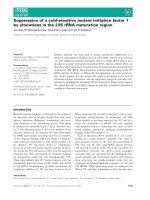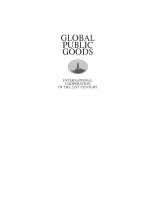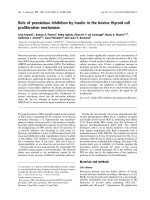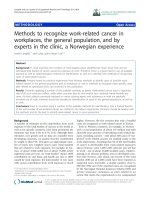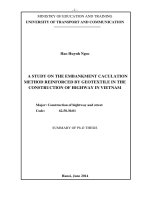Topic exporting goods by thailand in the period 2015 2022suggestions to vietnam
Bạn đang xem bản rút gọn của tài liệu. Xem và tải ngay bản đầy đủ của tài liệu tại đây (645.39 KB, 25 trang )
NATIONAL ECONOMICS UNIVERSITY
SCHOOL OF ADVANCED EDUCATION PROGRAMS
INTERNATIONAL ECONOMICS
INDIVIDUAL ASSIGNMENT OF INTERNATIONAL
ECONOMICS
TOPIC: EXPORTING GOODS BY THAILAND IN THE PERIOD
2015-2022&SUGGESTIONS TO VIETNAM
Name
:NGUYỄN HÀ PHƯƠNG
Student ID
:11214794
Major
:Development Economics
Class
:Development Economics 63CLC
Instructor
:Associate Professor Ph.D Nguyễn Thường Lạng
Email
:
Mobile
:0983478486
Study Time
:Semester 2 of the academic year 2022-2023
Student Mobile :0941712864
Student Email
:
HANOI, 2/2023
GUARANTEE
I hereby declare that I have completed this assignment entirely on my own. To the
best of my knowledge, the statements and materials used in the exercise have been
cited, and are guaranteed to be precise to the highest degree. If the assignment is
not performed as specified above, I will accept full responsibility.
Hanoi, February 9, 2023
Prepare by
Nguyễn Hà Phương
THANK YOU
First and foremost, I would like to express my sincere gratitude to all of the
instructors at the National Economics University who have diligently taught and
brought with us valuable expertise and information.
I want to express my gratitude to Associate Professor Dr. Nguyen Thuong Lang in
particular since he helped me out in the exercise. Working with you has allowed
me to continue learning and gain a wealth of knowledge that will be very helpful to
me in the future. I have also had a serious and productive work spirit, both of
which will be essential for my career path.
Finally, I could not have completed this essay without the support of my family
and friends who have always encouraged, contributed ideas and helped in the
process of studying and researching to complete this exercise.
Hanoi, February 9, 2023
Prepare by
Nguyễn Hà Phương
OPENING
CHAPTER 1: THEORETICAL BASIS ON EXPORT
1.1. The concept of export
1.2.The types and role of export
1.3.The factors that affect export goods
CHAPTER 2: THE STATE OF EXPORTING GOODS BY
THAILAND IN THE PERIOD 2015-2022
2.1.Thailand’s export turnover in the period 2015-2022
2.2. Thailand’s main export goods
2.3. Thailand's major export markets
2.4.The overall assessment of Thailand’s export situation
2.5. The orientation to export in 2023
CHAPTER 3:SUGGESTION TO VIETNAM
3.1.The comparision between Thailand’s export and Vietnam’s export
3.2.The proposed solution for exporting goods by Vietnam
CONCLUSION
LIST OF REFERENCES
INTRODUCTION
1.Inevitability of topic selection
Sustainable economic growth is always the top goal of each country in order to
comprehensively develop socio-economic and improve people's living standards.
One of the important factors affecting economic growth is exports.
Thailand has a new industrial market economy that is heavily dependent on
tourism and exports, with exports accounting for about 60% of GDP. It is the 2nd
largest economy in the ASEAN region (after Indonesia), 25th globally by nominal
GDP, 21st in the world by purchasing power parity, and 28th in the world. the
world in terms of total national brand value (statistics in 2020).
Meanwhile, Vietnam moved from a centrally planned economy to a market
economy and opened up to international economic integration. The implementation
of industrialization and modernization in line with the Party's renovation line has
actively contributed to the initial change in the economic face of the country. In
1986, Vietnam really entered the period of reform and opening up with the motto
of diversification, multilateralization, wanting to be friends with all countries….
Vietnam is well aware of the importance of exports. It has brought success and
prosperity to many countries in East Asia and Southeast Asia such as Singapore,
Malaysia and Thailand. Up to now, after more than 20 years of renovation, reform
and opening up, towards export, Vietnam's economy has achieved many
achievements, but there are also many challenges and difficulties that require
solutions. new approach on the basis of selective lessons learned from previous
countries.
Vietnam and Thailand have some similarities in terms of economic, natural and
social conditions. Therefore, studying the export process of Thailand not only has
theoretical and practical significance, but also has an empirical reference for the
export process in Vietnam today. That's why I chose the topic: "EXPORTING
GOODS BY THAILAND IN THE PERIOD 2015-2022&SUGGESTIONS TO
VIETNAM" as my research content.
2..The research’s goals and tasks
2.1.The research’s goals
On the basis of analyzing the current situation, assessing the results as well as the
export restrictions of products by Thailand in the period 2015-2022, thereby
proposing orientations and solutions for the commodity export market of Vietnam
in the coming years.
2.2.The research tasks
To achieve the above research purpose, the research will perform the following
tasks:
First, state export theories
Second, analyze the status of commodity exports by Thailand in the period of
2022-2013, draw assessments about the achieved results and shortcomings.And
also show the export orientations of Thailand in the coming years.
Third, from the comparisons between Thailand's exports and Vietnam's exports, I
propose some solutions to improve Vietnam's exports in the coming years.
3.The research’s subject and scope
3.1 Subject: export of goods by Thailand
3.2 Scope: exports of goods by Thailand for the period 2015-2022
4.The research methods
This study uses analysis, synthesis and comparison methods to solve the posed
problem.
Data are collected from Customs offices, General Statistics Office of Thailand and
Vietnam.
5. Structure of the essay
In addition to the table of contents and the list of references, the introduction,
conclusion, and main content of the essay includes 3 chapters, as follows:
Chapter 1: Theoretical basis for export
Chapter 2: Thailand's commodity exports in the period 2015-2022
Chapter 3: Some experiences for Vietnam from Thailand's exports
CHAPTER 1: THEORETICAL BASIS ON EXPORT
1.1. The concept of export
Exports are goods and services that are produced in one country and sold to
buyers in another. Exports, along with imports, make up international trade.
Exports are incredibly important to modern economies because they offer
people and firms many more markets for their goods. One of the core functions
of diplomacy and foreign policy between governments is to foster economic
trade, encouraging exports and imports for the benefit of all trading parties by
the specialization of production by each country.
Export agreements are often heavily strategic, with countries exchanging
agreements to ensure their own country can not only receive the goods they
need via export but can distribute goods for more domestic revenue via imports.
Net exports is a component of measuring a country's gross domestic product
(GDP), so exports play a factor in determining a country's financial and
economic well-being.
1.2.The types and role of export
1.2.1.The types of Exporting
When it comes to exporting, there are two main types - direct exporting and
indirect exporting.
Direct exporting is a type of exporting where the company directly sells
products to overseas customers. All the deals are done directly between the
companies without any intermediaries. This way, the companies have more
control over the processes. Direct exporting also increases profits as the
intermediary is eliminated, reducing costs. Direct exporting also creates a
stronger bond between the supplier and the buyer, and maintaining business
relationships is crucial for business success.
Despite the advantages mentioned above, direct exporting also demands more
resources from the exporting company. This exporting type requires more
personnel, resources, and time than it would if the export process were to
happen through an intermediary.
Direct exporting is the best strategy for companies trying to penetrate new
markets globally for the long term.
Indirect exporting is a type of exporting practiced by companies that sell
products to other countries with the help of an intermediary. The company has
various intermediaries, such as foreign agents, export merchants, expert
management companies, etc. Here, businesses have lesser control over the
processes.
The intermediaries are present in the country producing the product. They are
responsible for sending the products to the customer's country and finishing all
the paperwork, transport, and marketing. The first intermediary may sell
directly to the customer or the customer's intermediary.
Indirect exporting is less expensive than direct exporting. It is easier to cancel
indirect exports than direct exports. The main disadvantage of indirect
exporting is the transfer of power to the intermediaries. As a result, companies
may lose the opportunity to build long-term relationships and offer after-sales
services to customers.
Indirect exporting is a strategy best suited for companies trying to increase
profits quickly.
1.2.2.The role of Exporting
a) Higher revenue to the business
Help increase sales, diversify output markets to create a stable source of income
that can be expanded to the world.
b) Government Support
Governments often encourage exports as they boost the international economy
and increase the flow of foreign currency into the exporting country. This trade
can work in favor of the country's economy.
c) Create jobs and improve people's lives
Exporting goods to the international market has a very large scale. This, in turn,
provides employment opportunities for many people to help improve people's
living standards.
d) Promote corporate and national brands in the international market
The strong companies that export many valuable products to the international
market, in addition to dominating the market, also help affirm the company's
name. A country with many strong brands is also asserting its own brand. This
can be clearly seen through the contributions of big names to national brands
such as: Microsoft, Apple (USA), Sony, Toyota (Japan), Samsung, Hyundai
(Korea), Lenovo, Alibaba (China)…
e) Expand and build relationships with countries around the world
Exporting goods makes it possible for a country to build new relationships with
other countries.Thus, this also makes the friendship between a country and
other countries more cohesive and durable.
1.3.The factors affect to export goods
1. Subjective factors from countries
a. Development strategies and legal systems of exporting and importing
countries
Each country's development strategy is a set of goals and objectives to be
achieved over a long period of time. Based on strategies and policies, countries
will have specific legal provisions on import and export activities as well as
state management of import and export to achieve the common goal of the
country.
b. Consumption demand of the importing country
Increased consumer demand in the importing country creates an impetus for
the host country to increase exports. The main reason is that traders are
optimistic about the future prospects of sales in addition to the increase in
product selling prices due to increased demand.
c. The production capacity of the exporting country
The design, quality and output of products meet international tastes, the
development potential and competitiveness of export goods as well as export
enterprises will be very high in the international market.
d. Level of development of facilities, techniques and export services
Advanced infrastructure, warehouses, convenient and modern roads, export
services with high specialization help reduce logistics costs, reduce costs, and
increase competitiveness in the international market.
e. Competitiveness of export enterprises
Healthy competition will ensure sustainable development. Competition helps
export enterprises to constantly invest in technology development and product
quality. At the same time, competition also contributes to eliminating weak and
incompetent enterprises.
2. World objective factors
a. Exchange rate
When the exchange rate increases, the domestic currency appreciates relative
to the foreign currency, the price of exported goods becomes more expensive,
thereby negatively affecting export supply and vice versa. Therefore, the
devaluation of the domestic currency is a common policy of countries to boost
exports. Along with that, the import of goods increases if the exchange rate
falls because then the price of imported goods decreases relative to domestic
goods.
b. World economic and political situation
Although this is a macro factor, it has a strong impact on export activities. A
trade war, a global recession or even a pandemic will put the import and export
of every country in a difficult situation. A typical example for the impact of
this factor is the supply chain disruption due to measures to close the border to
serve the prevention of the Covid-19 epidemic in many countries in 2020.
CHAPTER 2: THE STATE OF EXPORTING GOODS BY THAILAND IN
THE PERIOD 2015-2022
2.1.Thailand’s export turnover in the period 2015-2022
1.The first period (2015-2019)
Slowing growth in the period 2013 - 2015 due to the domestic political crisis as
well as the decrease in global demand has reduced Thailand's traditional
strength exports: electronics, agricultural goods, umbrellas. auto parts and
accessories, processed food. Thailand's exports in 2015 reached 213.4 billion
USD. And from 2016 to 2018, the Thai economy had a recovery, the GDP
growth rate in 2016 was 3.3% ($412 billion), in 2017 it was 3.9% ($455 billion)
and the first quarter of 2018. I/2018 was 4.8%. At that time, Thailand's export
turnover also increased gradually. 2016 to 2018 from 214 to 251 billion USD in
2018. In macroeconomic policy, Thailand identifies exports as the engine of
economic development with exports accounting for 60% of GDP.By 2019, The
overall global economy in 2019 expanded at a slower pace from the previous
year. Several countries were affected by the slowdown in global trade volume
partly due to intensifying trade tensions between the US and China. As a result,
exports and manufacturing production in various countries contracted. Business
sentiment and investment were affected by uncertainties throughout the year
such as international trade protectionism measures, Brexit and geopolitical
risks. Nonetheless, private consumption remained an important growth driver in
many countries. Looking ahead, the global economy was expected to recover
gradually in line with the improvement in international trade situation after the
U.S. and China reached an agreement on the phase one trade deal and the
recovery of the electronic cycle. However, there remained risks that warranted
close monitoring, including (1) the spreading and severity of the COVID19
outbreak, (2) trade tensions between the U.S. and China that could become
intensified and (3) geopolitical risks in many areas. The Thai economy in 2019 .
below its potential level, due to the impact of the continued contraction in
external demand on domestic demand becoming more pronounced.
Merchandise exports continued to contract in various categories as a result of
the slowdown in both trading partner economies and global trade volume
following the increased trade tensions between the U.S. and China.
Nevertheless, exports of some products benefited from the relocation of
production base to Thailand and substitution for Chinese products in the U.S.
market such as electrical appliances and tires.That made the export turnover in
Thailand reached 242.7 billion USD.
2.The second period( 2020-2022)
The outbreak of the COVID-19 acute respiratory infection pandemic may cause
damage to the country's export industry, and it has caused Thailand's
merchandise export turnover in 2020 to decrease by nearly 16 billion USD
compared to 2019. and set at 227 billion USD. For the whole year of 2021,
Thailand's exports increased by 17.1% to 271 billion USD. Such strong export
growth during the COVID-19 outbreak can be attributed to accelerated imports
in many countries to stockpile ahead of the holiday season; improved
semiconductor shortage; and the implementation of the export promotion plan
of the Ministry of Trade. At the same time, foreign demand and global trade
volume improved along with the recovery of the world economy. Furthermore,
the devaluation of the baht and high crude oil prices have helped increase the
competitiveness and value of related export products. By the first quarter of
2022, Thailand's exports grew 14 percent, 9%, reaching 73.6 billion USD.
Thus, the export value of goods (excluding gold, petroleum-related products
and weapons) of Thailand has continuously grown for 13 consecutive months.
Export products recorded with a strong increase in March include goods
benefiting from gasoline prices and a number of other goods increasing such as:
Iron, steel, crude oil, refined oil, chemicals. , plastics, rubber tires and
agricultural and food products. In addition, a number of other goods also saw a
sharp increase in exports such as household appliances, computers, televisions,
phones as well as medical products to prevent and control the Covid-19
epidemic, which are still in demand.
“The strong growth in Thai exports has been attributed to strong global demand,
in part due to the improved Covid-19 situation. The impact of the RussianUkrainian military conflict on Thailand is also relatively limited as these two
countries account for only a very small proportion of Thailand's total exports.
Thailand in 2022 reached the milestone of 287 billion USD.
2.2.Thailand’s main export goods
Thailand has identified 5 priority sectors including Agriculture, Electronics,
Agro-manufactured products, Automotive, Apparel and Textile Materials. As
the world's second largest rice exporter (after India), agriculture has always
played an extremely important role, contributing to the development of the Thai
economy. Sustainable agricultural development is considered one of Thailand's
main economic drivers. Not only is it one of the world's leading rice exporters,
Thailand's other agricultural products also have major export metals such as
sugar, pears, and rubber. Besides, The manufacturing sector is diversifying and
that has contributed much to growth during the economic boom. Fast-growing
industries include: computers and electronics, apparel and textile goods,
furniture, wood products, canned foods, toys, plastic products, gems and wares
jewelry. High-tech products such as components and integrated circuits,
electrical appliances, and motor vehicles are leading Thailand's export
growth.Thailand's exports are stronger after 2020 thanks to the strengthening of
global demand, partly thanks to the improvement of the Covid-19 epidemic
situation.
2.3. Thailand's major export markets
From 2019-2021, the United States is Thailand's largest export market with the
main items being rubber, automobiles and components, gems and jewelry, and
the second largest supplier after China. with chemicals. Followed by the
Japanese market. Countries in ASEAN also contribute a lot in Thailand's
development turnover such as Vietnam, Malaysia, Singapore, etc.
2.4.The assessment of Thailand’s export situation
In general, from 2015-2019, there was a fluctuation in the export situation and
was evident in the first year and 2020. In 2015, Thailand's export situation
slowed down due to the political situation in the country. From 2016 to 2018,
the Thai economy recovered and then, Thailand's export turnover also increased
gradually. By 2019, the global economy was expanding at a slower rate than the
previous year. Several countries were affected by the decline in global trade
volumes in part due to increased trade tensions between the US and China.
Business and investment sentiment was affected by uncertainties throughout the
year such as protectionist international trade measures, Brexit and geopolitical
risks. However, exports of some products benefited from shifting production to
Thailand and replacing Chinese goods in the US market, such as electrical
appliances and tires. The outbreak of the COVID-19 acute respiratory infections
caused damage to the country's export industry, and it caused a decrease in
Thailand's merchandise export turnover in 2020. By 2021, export growth strong
during the COVID-19 outbreak can be attributed to accelerated imports in many
countries to stockpile ahead of the holiday season; improved semiconductor
shortage; and the implementation of the export promotion plan of the Ministry
of Trade. At the same time, foreign demand and global trade volume improved
along with the recovery of the world economy.
2.5.The orientation to export in 2023
In order to promote exports, solve obstacles to trade and limit the negative
effects of the global economic recession in 2023, Thailand is targeting a group
of countries including Cambodia, Laos, Myanmar and Vietnam.Thailand aims
to export to the market of 4 countries next year, increasing to 33.5 billion USD
from 28 billion USD this year. Major export items include construction
materials, electrical equipment, plastic beads, and garments.Along with the
Middle East and South Asia, Cambodia, Laos, Myanmar and Vietnam are
considered as one of the three high potential export markets of Thailand next
year.Thailand's Ministry of Commerce also pledged to increase border trade
with these countries next year, especially in food, fruits and vegetables.
CHAPTER 3:SUGGESTION TO VIETNAM
3.1.The comparision between Thailand’s export and Vietnam’s export
As we can see, from 2015 to 2018, Thailand's export turnover surpassed
Vietnam's, but this gap gradually narrowed. By 2019, marking a big transition
when Vietnam's export turnover Vietnam has surpassed Thailand with 21
billion USD. And in the coming years between 2020 and 2022, while the world
is still unstable, the prospect of Vietnam is quite positive. During this period,
Vietnam's export turnover has still surpassed Thailand's. In 2021, Vietnam's
export turnover reached 336 billion USD while that of Thailand only reached
271 billion USD. And by 2022, that of Vietnam was more than Thailand's to
$85 billion.
Over 10 years, by 2018, Vietnam has had an impressive growth rate ranked
26th in terms of exports. Accordingly, Vietnam is continuously in the group of
30 countries and territories with the largest import-export turnover in the world.
Exports increased sharply, but the level of dependence on enterprises with
foreign investment capital (FDI) was large, accounting for about 74% of total
export turnover. In contrast, the export capacity of domestic enterprises,
especially small and medium enterprises, is not high.
The pace of market diversification of some products, such as vegetables and
fruits, is still slow, so it has not met the requirements on standards, quality, or
made good use of signed FTAs. The transition from clean to official quota
exports is still slow.
At the conference, Deputy Foreign Minister-Nguyen Minh Vu commented,
2023 will be more complicated when many economies around the world are
forecasted to have high inflation; The world economy is likely to have a
technical recession... leading to a decrease in purchasing power and global
consumption.
Trading partners are also more demanding, such as adjusting regulations related
to reducing carbon emissions, or tightening quality with imported goods.
"Certainly, customers will be more demanding in association with commercial
and non-commercial conditions, requiring businesses and export industries to
have a response scenario," Mr. Vu noted.
3.2.The proposed solution for exporting goods by Vietnam
1.Strengthening the attraction of foreign investment capital at the same time
as mobilizing domestic capital, besides having an effective capital use plan
a) Regarding foreign capital sources
From the above experience, Vietnam needs to attach importance to both FDI
and loan capital. In order to attract loans, Vietnam must have specific policies
and solutions:
- Firstly, improve the investment environment through administrative reform,
simplify investment procedures and offer tax, credit, and infrastructure
preferential packages for priority areas. promote investment and development.
- Second, complete regional and sectoral plans to be ready to call for
investment.
- Third, it is necessary to have a suitable and attractive land policy for
foreigners to invest in Vietnam.
b) Regarding domestic capital
From the experience in mobilizing and using Thailand's capital and how
Vietnam's capital is used over the years, we can see that Vietnam has been very
successful in raising capital but has not used it effectively. the results of the
funds mobilized. for the appraisal of investment plans and projects, it is
necessary to have a unified mechanism for managing and allocating capital for
capital construction on the basis of 5-10 year socio-economic development
strategies to avoid investment duplication, causing waste.
2.Building a dynamic and efficient economic structure
From the experience of Thailand and the experience of industry restructuring
over the years in Vietnam, we can see that in order to accelerate the economic
restructuring process, an industry restructuring strategy brings Overall and
consistency needs to be done, which is to prioritize the development of laborintensive, low-capital-intensive and export-oriented industries. On that basis,
on the one hand, implement measures to upgrade existing facilities in the value
chain; on the other hand, select a number of fields that have the potential to
become highly competitive industries in the future to persistently, decisively,
and fully achieve, creating the necessary conditions for human resources.
equipment, infrastructure, technology... for the turning point of economic
restructuring towards modernity in the future. To promote such economic
restructuring, Vietnam needs to pay attention to creating a market-supporting
institution, making the market work better, thereby optimally allocating
available resources. countries based on comparative advantage. At the same
time, the state needs to identify priority directions and encourage investment in
the identified priority areas. The State will play the role of an investor in a
number of fields necessary to create a support base for the business sector to
develop. Specifically, (1) select industries to focus on development; and (2)
Identify areas for direct state investment.
3.Solving well the relationship between rapid growth and sustainable
development
- From the experiences of Thailand, we can draw for ourselves future
orientations in sustainable development as follows: - Firstly, successfully
exploit foreign investment, while also being able to orient future paths through
reinvestment programs. The immediate priority is to focus on industries that
Vietnam has a competitive advantage with, paying much attention to the quality
factor. - Second, it is necessary to launch fields with high potential thanks to
new science and technology.
- Third, environment - economy - society - three factors that cannot be
separated in the development process.
4.Diversify markets, maintain and improve product quality
+ Market policy Vietnam needs to continue to maintain important markets
such as the US, Japan and the EU, specifically as follows:
For the US market, Vietnam has signed a BTA bilateral trade agreement, so
Vietnamese goods are also easy to penetrate into this market. But the US
market is not as easy as we see it, because the US always creates technical
barriers to prevent products from developing countries including Vietnam.
Therefore, it is extremely important to negotiate the Generalized Systems
Preferential (GSP) with the United States.
For the Japanese market, Vietnam and Japan have signed a strategic
partnership agreement. Japan is the second largest economy after the US and
the 21st largest ODA donor for Vietnam. Therefore, promoting trade activities
is beneficial for both countries. However, since this is a comprehensive
economic partnership agreement, not merely a free trade agreement, in addition
to goods, there are also services that will be liberalized. Investments of one
country in another will be protected. And there are many other economic
cooperation contents. This is an opportunity for Vietnamese goods to enter the
Japanese market and at the same time a big challenge for Vietnam because it
has to compete with high-tech products from Japan. Therefore, besides
maintaining traditional export products, Vietnam must introduce new products
with high technology content.
For the EU market: Until now, the EU has expanded to 27 member countries. It
is the largest and most closely operated economic union in the world. The
union is also the most prosperous commercial region in the world. In recent
years, the growth rate of Vietnam's exports to the EU market has been higher
than the growth rate of imports. Therefore, Vietnam becomes a surplus
exporter with this market. Vietnam's policy towards this market needs to be
maintained
this market by improving the competitiveness of Vietnamese exports. At the
same time, it is necessary to take advantage of and take advantage of the
knowledge and high technology of this market. For the Chinese market. Due
to its geographical location and population, the Chinese market is Vietnam's big
market. Chinese products are cheap and suitable for Vietnamese people, so
Vietnamese products of the same type have to compete fiercely with Chinese
products. In the last 5 years, Vietnam has become a large trade deficit country
of China. In addition, other markets such as ASEAN countries, CIS and other
continents also play an important role for Vietnamese products. Therefore, we
must continue to strengthen intra-ASEAN trade policy while restoring and
expanding relations with CIS countries.
Product policy: Vietnam still has to maintain traditional products but must
improve the quality of products to maintain export markets. At the same time
create new products with high technology content to compete in existing and
new markets. 3.3.8. Focusing on improving the quality of human resources
and promoting the development of science and technology for the
industrialization process CNH
5.Improve human resources
From the experiences of Thailand and the reality of Vietnam, it is necessary to
solve some of the following problems in order to strongly develop human
resources:
Firstly, reforming educational management thinking is an issue that needs to be
carried out first. To renovate education, education managers must first change
their thinking before forcing educators to change their thinking. Only then can
Vietnam's education reform be radically and strongly reformed.
Second, carry out education reform systematically. Systematic education
reform means that reform is not only aimed at a particular stage of the training
process, but must be reformed as a whole from the general education,
vocational training and university levels. Because if we only focus on
education at the university level, we will probably only do the top. Because we
all know that the output of this level is the input of the next level.
Third, improve the quality of training according to international standards. In
the process of integration, improving the quality of human resources to
international level is of special importance. Through raising the international
level, we have the opportunity to compare and compete with other countries for
high quality human resources. In the immediate future, bring Vietnam's
education quality to the regional level and then move up to the world level.
6.Strengthening the development of science and technology to serve the process
of producing export goods.
From the reality of Vietnam, we see that Vietnam needs to take the following
steps:


